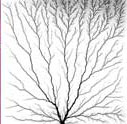Lichtenberg Patterns
Patterns such as this one were generated artificially for the first time by Lichtenberg in the eighteenth century. For this reason they are referred to as ``Lichtenberg'' patterns. To create this pattern, we first (1) loaded the plastic with electrons; and, (2) then we discharged it. To load a piece of half inch, clear acrylic plastic, we put it in front of an electron beam at Hanscomb Air Force Base, Massachusetts. The electron beam was generated by a Van deGraaf accelerator. Each electron had the same energy, so when they hit the plastic, they all stopped at the same depth -- roughly half-way through the plastic block. If you were to look through the plastic block on edge, you would find that it was clear, except at the center where all the electrons stopped. To keep the electrons from escaping from the plastic, or prematurely discharging, we kept the plastic very cold (-80 C). To discharge the plastic, the block was stood on it side. At the base of the pattern you are observing, a sharp metal point was placed (e.g., an awl) was placed and struck with a hammer. The metal point served as a discharge point to ground, just as a lightning rod on a house, or a tree in a field, or a key on Ben Franklin's kite, does for the charges in a cloud. All the stored electrons in the plastic drained out through the point where the metal point struck. The main process took less than 40 nanoseconds (40 billionths of a second). Secondary discharges continue for many minutes afterward.
|
 This image is a photograph of a branching pattern in a piece of
plastic. The pattern was created by a process known as ``dielectric
breakdown''. It looks like a lightning stroke frozen in time,
and for good reason: its creation follows the same basic laws as
the flash of lightning in a storm.
This image is a photograph of a branching pattern in a piece of
plastic. The pattern was created by a process known as ``dielectric
breakdown''. It looks like a lightning stroke frozen in time,
and for good reason: its creation follows the same basic laws as
the flash of lightning in a storm.